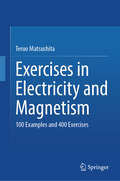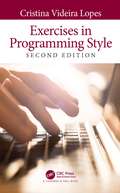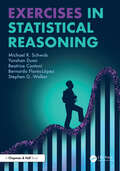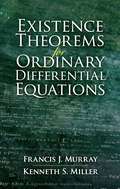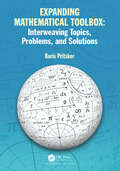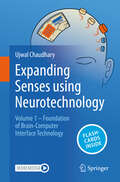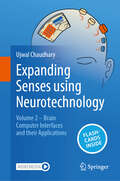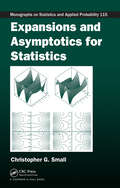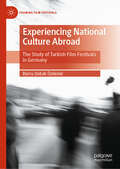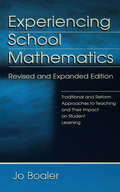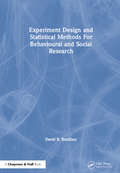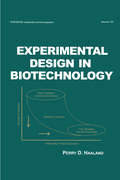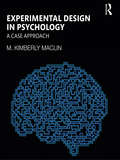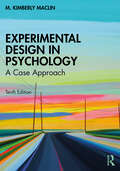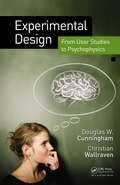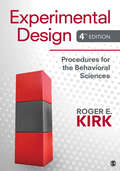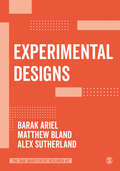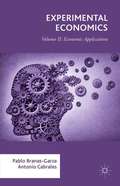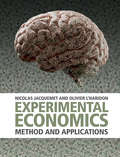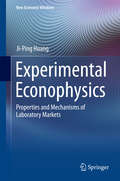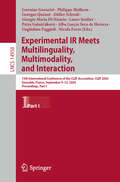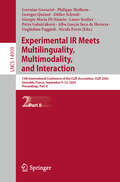- Table View
- List View
Exercises in Electricity and Magnetism: 100 Examples and 400 Exercises
by Teruo MatsushitaThis book covers a great variety of problems on electricity and magnetism described in the textbook, "Electricity and Magnetism", in which superconductors are classified as one kind of magnetic materials. These problems will be helpful for a deeper understanding of the E-B analogy through a comparison between static electric and magnetic phenomena. Additionally, the usefulness of the vector potential is widely introduced. For example, the vector potential is directly used to determine the induced electromotive force. The author provides various exercises that are not covered in the textbook. The Poynting vector is useful for understanding the energy flow into capacitors or transmission lines during a charging process or into resistors during a dissipation process. A comparison between normal conducting and superconducting transmission lines shows a clear difference in the energy flow, although the final stored magnetic energy is the same. The electromagnetic potential of electromagnetic transverse electric (TE) and transverse magnetic (TM) waves in a waveguide also presents an interesting difference: The electric potential is zero in one case and non-zero in the other case. The reason for such a difference is explored. The relationship between the electric charge and electric current induced on the conductor surface is investigated for an electromagnetic wave in a waveguide or for that reflected on a conductor surface. This exercise book can be used together with the textbook 'Electricity and Magnetism' by the same author.
Exercises in Programming Style
by Cristina Videira LopesThe first edition of Exercises in Programming Style was honored as an ACM Notable Book and praised as "The best programming book of the decade." This new edition retains the same presentation but has been upgraded to Python 3, and there is a new section on neural network styles. Using a simple computational task (term frequency) to illustrate different programming styles, Exercises in Programming Style helps readers understand the various ways of writing programs and designing systems. It is designed to be used in conjunction with code provided on an online repository. The book complements and explains the raw code in a way that is accessible to anyone who regularly practices the art of programming. The book can also be used in advanced programming courses in computer science and software engineering programs. The book contains 40 different styles for writing the term frequency task. The styles are grouped into ten categories: historical, basic, function composition, objects and object interactions, reflection and metaprogramming, adversity, data-centric, concurrency, interactivity, and neural networks. The author states the constraints in each style and explains the example programs. Each chapter first presents the constraints of the style, next shows an example program, and then gives a detailed explanation of the code. Most chapters also have sections focusing on the use of the style in systems design as well as sections describing the historical context in which the programming style emerged.
Exercises in Statistical Reasoning (Chapman & Hall/CRC Texts in Statistical Science)
by Michael R. Schwob Yunshan Duan Beatrice Cantoni Bernardo Flores-Lopez Stephen G. WalkerStudents cultivate learning techniques in school that emphasize procedural problem solving and rote memorization. This leads to efficient problem solving for familiar problems. However, conducting novel research is an exercise in creative problem solving that is at odds with a procedural approach; it requires thinking deeply about the topic and crafting solutions to unique problems. It is not easy to move from a topic-based, carefully curated curriculum to the daunting world of independent research, where solutions are unknown and may not even exist. In developing this book, we considered our experiences as graduate students that faced this transition.Exercises in Statistical Reasoning is a collection of exercises designed to strengthen creative problem-solving skills. The exercises are designed to encourage readers to understand the key points of a problem while seeking knowledge, rather than separating out these two activities. To complete the exercises, readers may need to reference the literature, which is how research-based knowledge is often acquired.Features of the Exercises The exercises are self-contained, though several build upon concepts from previous problems. Each exercise opens with a brief introduction that emphasizes the relevance of the content. Then, the problem statement is presented as a series of intermediate questions. For each exercise, we suggest one possible solution, though many may exist. Following each solution, we discuss the historical background of the content and points of interest. For many exercises, a brief demonstration is provided that illustrates relevant concepts. There is an abundance of high-quality textbooks that cover a vast range of statistical topics. However, there is also a lack of texts that focus on the development of problem-solving techniques that are required for conducting novel statistical research. We believe that this book helps fill the gap. Any reader familiar with graduate-level classical and Bayesian statistics may use this book. The goal is to provide a resource that such students can use to ease their transition to conducting novel research.
Existence Theorems for Ordinary Differential Equations (Dover Books on Mathematics)
by Kenneth S. Miller Francis J. MurrayTheorems stating the existence of an object—such as the solution to a problem or equation—are known as existence theorems. This text examines fundamental and general existence theorems, along with the Picard iterants, and applies them to properties of solutions and linear differential equations.The authors assume a basic knowledge of real function theory, and for certain specialized results, of elementary functions of a complex variable. They do not consider the elementary methods for solving certain special differential equations, nor advanced specialized topics; within these restrictions, they obtain a logically coherent discussion for students at a specific phase of their mathematical development. The treatment begins with a survey of fundamental existence theorems and advances to general existence and uniqueness theorems. Subsequent chapters explore the Picard iterants, properties of solutions, and linear differential equations.
Expanding Mathematical Toolbox: Interweaving Topics, Problems And Solutions
by Boris PritskerExpanding Mathematical Toolbox: Interweaving Topics, Problems, and Solutions offers several topics from different mathematical disciplines and shows how closely they are related. The purpose of this book is to direct the attention of readers who have an interest in and talent for mathematics to engaging and thought-provoking problems that should help them change their ways of thinking, entice further exploration and possibly lead to independent research and projects in mathematics. In spite of the many challenging problems, most solutions require no more than a basic knowledge covered in a high-school math curriculum. To shed new light on a deeper appreciation for mathematical relationships, the problems are selected to demonstrate techniques involving a variety of mathematical ideas. Included are some interesting applications of trigonometry, vector algebra and Cartesian coordinate system techniques, and geometrical constructions and inversion in solving mechanical engineering problems and in studying models explaining non-Euclidean geometries. This book is primarily directed at secondary school teachers and college professors. It will be useful in teaching mathematical reasoning because it emphasizes how to teach students to think creatively and strategically and how to make connections between math disciplines. The text also can be used as a resource for preparing for mathematics Olympiads. In addition, it is aimed at all readers who want to study mathematics, gain deeper understanding and enhance their problem-solving abilities. Readers will find fresh ideas and topics offering unexpected insights, new skills to expand their horizons and an appreciation for the beauty of mathematics.
Expanding Senses using Neurotechnology: Volume 1 ‒ Foundation of Brain-Computer Interface Technology
by Ujwal ChaudharyThis book is an essential guide for students, researchers, and professionals in the interdisciplinary field of neurotechnology. This comprehensive volume delves into the intricate world of brain signal acquisition, exploring both invasive and non-invasive techniques like EEG, fNIRS, fMRI, and DBS. Through case studies, including groundbreaking communication systems for ALS patients and neurofeedback mechanisms, readers will learn how theoretical concepts are transformed into life-changing technologies. The book traces the historical milestones of neurotechnology and discusses the latest advancements in brain signal processing and neurostimulation techniques. Readers will gain an understanding of how machine learning models enhance neurotechnology applications and how ethical considerations shape the future of this rapidly evolving field. This book offers invaluable insights into the tools, techniques, and applications that are revolutionizing the way we understand and interact with the human brain. Join us on a journey through the past, present, and future of neurotechnology, and discover how this fascinating field is poised to transform healthcare, enhance human capabilities, and improve the quality of life for millions worldwide. This book contains 120 questions and answers: Download the Springer Nature Flashcards App free of charge and use exclusive additional material to test your knowledge.
Expanding Senses using Neurotechnology: Volume 2 ‒ Brain Computer Interfaces and their Applications
by Ujwal ChaudharyThis book provides a comprehensive exploration of the transformative field of brain-computer interfaces (BCIs) and neurotechnology. As the fusion of neuroscience, engineering, and artificial intelligence advances, this textbook guides readers through foundational principles and recent innovations that are reshaping how we understand and enhance brain-body abilities. From non-invasive BCIs and their role in communication and motor restoration to invasive BCIs designed for individuals with locked-in syndrome and beyond, each chapter delves into cutting-edge applications, including neurofeedback therapy and treatments for neuropsychiatric conditions like ADHD and depression. Additionally, the textbook addresses the crucial ethical, legal, and societal implications, exploring concerns over mental privacy, informed consent, and the commercialization of brain data. Intended for students, researchers, and professionals in neuroscience, biomedical engineering, and related fields, this text serves as both a technical guide and an ethical roadmap to the profound future of neurotechnology. This book contains more than 110 questions and answers: Download the Springer Nature Flashcards App free of charge and use exclusive additional material to test your knowledge.
Expansions and Asymptotics for Statistics (Chapman & Hall/CRC Monographs on Statistics and Applied Probability)
by Christopher G. SmallAsymptotic methods provide important tools for approximating and analysing functions that arise in probability and statistics. Moreover, the conclusions of asymptotic analysis often supplement the conclusions obtained by numerical methods. Providing a broad toolkit of analytical methods, Expansions and Asymptotics for Statistics shows how asymptoti
Experiencing National Culture Abroad: The Study of Turkish Film Festivals in Germany (Framing Film Festivals)
by Burcu Dabak ÖzdemirImmigrant film festivals are multifaceted events where complex networks of identities and symbolic values are constructed, circulated, and debated through various channels, including program screenings, ancillary events, press releases, financial backing, and audience engagement. As such, immigrant film festivals can be seen as discourse-producing practices. Based on this idea, this book offers a comprehensive study of three prominent Turkish film festivals in Germany: the International Frankfurt Turkish Film Festival, the Nuremberg Turkey/Germany Film Festival, and the Munich Turkish Film Days. The overarching objective is to comprehend the multifaceted influence of these festivals on the construction of discourses on Turkish immigrant identity while also seeking to illuminate how these festivals reshape both the host country and the country of origin and produce ideas for Turkish immigrants This is achieved through an examination of the diverse representation strategies engendered by these festivals. By employing a multifaceted research approach—including content analysis, audience studies, semi-structured interviews with festival managers, and participant observation—this study seeks to provide a nuanced understanding of the complex interplay between immigrant film festivals, cultural identity formation, and the socio-political dynamics within both the host and origin countries. Through rigorous scholarly inquiry, it aims to contribute to academic discourse on the role of film festivals in shaping cultural narratives, fostering intercultural dialogue, and facilitating processes of integration and belonging within immigrant communities.
Experiencing School Mathematics: Traditional and Reform Approaches To Teaching and Their Impact on Student Learning, Revised and Expanded Edition (Studies in Mathematical Thinking and Learning Series)
by Jo BoalerNORTH AMERICAN RIGHTS ONLY: This is a revised edition of Experiencing School Mathematics first published in 1997 by Open University Press, © Jo Boaler. This revised edition is for sale in North America only.The first book to provide direct evidence for the effectiveness of traditional and reform-oriented teaching methods, Experiencing School Mathematics reports on careful and extensive case studies of two schools that taught mathematics in totally different ways. Three hundred students were followed over three years, providing an unusual and important range of data, including observations, interviews, questionnaires, and assessments, to show the ways students' beliefs and understandings were shaped by the different approaches to mathematics teaching. The interviews that are reproduced in the book give compelling insights into what it meant to be a student in the classrooms of the two schools. Questions are raised about and new evidence is provided for: * the ways in which "traditional" and "reform oriented" mathematics teaching approaches can impact student attitude, beliefs, and achievement; *the effectiveness of different teaching methods in preparing students for the demands of the "real world" and the 21st century; *the impact of tracking and heterogeneous ability grouping; and *gender and teaching styles--the potential of different teaching approaches for the attainment of equity. The book draws some radical new conclusions about the ways that traditional teaching methods lead to limited forms of knowledge that are ineffective in non-school settings. This edition has been revised for the North American market to show the relevance of the study results in light of the U.S. reform movement, the "math wars" and debates about teachers, assessment, and tracking. The details of the study have been rewritten for an American audience and the results are compared with research conducted in the U.S. This is an important volume for mathematics teachers and researchers, education policymakers, and for students in mathematics education courses. NOTE: This is a revised edition of Experiencing School Mathematics first published in 1997 by Open University Press, © Jo Boaler. This revised edition is for sale in North America only.
Experiment Design and Statistical Methods For Behavioural and Social Research
by David R. BonifaceExperiment Design and Statistical Methods introduces the concepts, principles, and techniques for carrying out a practical research project either in real world settings or laboratories - relevant to studies in psychology, education, life sciences, social sciences, medicine, and occupational and management research.The text covers: repeated measures unbalanced and non-randomized experiments and surveys choice of design adjustment for confounding variables model building and partition of variance covariance multiple regressionExperiment Design and Statistical Methods contains a unique extension of the Venn diagram for understanding non-orthogonal design, and it includes exercises for developing the reader's confidence and competence. The book also examines advanced techniques for users of computer packages or data analysis, such as Minitab, SPSS, SAS, SuperANOVA, Statistica, BMPD, SYSTAT, Genstat, and GLIM.
Experimental Design and Reproducibility in Preclinical Animal Studies (Laboratory Animal Science and Medicine #1)
by José M. Sánchez Morgado Aurora BrønstadThis highly-readable text provides grounds on how to plan and conduct animal experiments that can be reproduced by others. The book touches on factors that may impact the reproducibility of animal studies including: the animal genetic background, the animal microbial flora, environmental and physiological variables affecting the animal, animal welfare, statistics and experimental design, systematic reviews of animal studies, and the publishing process. The book addresses advanced undergraduates, graduate students and all scientists working with animals.
Experimental Design in Biotechnology (Statistics: A Series Of Textbooks And Monographs #105)
by Perry D. HaalandThis book provides the first time user of statistics with an understanding of how and why statistical experimental design and analysis can be an effective problem solving tool. It presents experimental designs which are useful for small screening and response surface experiments.
Experimental Design in Psychology: A Case Approach
by M. Kimberly MacLinThis text is about doing science and the active process of reading, learning, thinking, generating ideas, designing experiments, and the logistics surrounding each step of the research process. In easy-to-read, conversational language, Kim MacLin teaches students experimental design principles and techniques using a tutorial approach in which students read, critique, and analyze over 75 actual experiments from every major area of psychology. She provides them with real-world information about how science in psychology is conducted and how they can participate. Recognizing that students come to an experimental design course with their own interests and perspectives, MacLin covers many subdisciplines of psychology throughout the text, including IO psychology, child psychology, social psychology, behavioral psychology, cognitive psychology, clinical psychology, health psychology, educational/school psychology, legal psychology, and personality psychology, among others. Part I of the text is content oriented and provides an overview of the principles of experimental design. Part II contains annotated research articles for students to read and analyze. Classic articles have been retained and 11 new ones have been added, featuring contemporary case studies, information on the Open Science movement, expanded coverage on ethics in research, and a greater focus on becoming a better writer, clarity and precision in writing, and reducing bias in language. This edition is up to date with the latest APA Publication Manual (7th edition) and includes an overview of the updated bias-free language guidelines, the use of singular "they," the new ethical compliance checklist, and other key changes in APA style. This text is essential reading for students and researchers interested in and studying experimental design in psychology.
Experimental Design in Psychology: A Case Approach
by M. Kimberly MacLinThis text is about doing science and the active process of reading, learning, thinking, generating ideas, designing experiments, and the logistics surrounding each step of the research process. In easy-to-read, conversational language, Kim MacLin teaches students experimental design principles and techniques using a tutorial approach in which students read, critique, and analyze over 75 actual experiments from every major area of psychology. She provides them with real-world information about how science in psychology is conducted and how they can participate. Recognizing that students come to an experimental design course with their own interests and perspectives, MacLin covers many subdisciplines of psychology throughout the text, including IO psychology, child psychology, social psychology, behavioral psychology, cognitive psychology, clinical psychology, health psychology, educational/school psychology, legal psychology, and personality psychology, among others. Part I of the text is content oriented and provides an overview of the principles of experimental design. Part II contains annotated research articles for students to read and analyze. New sections on how to critically evaluate media reports of scientific findings (in other words, how to identify ‘fake news’), authorship guidelines and decisions, survey research methods and AI tools have been included. Further, expanded information on the Open Science movement, and on ethics in research, and methods to achieve clarity and precision in thinking and writing are included. This edition is up to date with the latest APA Publication Manual (7th edition) and includes an overview of the bias-free language guidelines, the use of singular "they," and an ethical compliance checklist.. This text is essential reading for students and researchers interested in and studying experimental design in psychology.
Experimental Design in Psychology: A Case Approach
by M. Kimberly MacLinThis text is about doing science and the active process of reading, learning, thinking, generating ideas, designing experiments, and the logistics surrounding each step of the research process. In easy-to-read, conversational language, Kim MacLin teaches students experimental design principles and techniques using a tutorial approach in which students read, critique, and analyze over 75 actual experiments from every major area of psychology. She provides them with real-world information about how science in psychology is conducted and how they can participate.Recognizing that students come to an experimental design course with their own interests and perspectives, MacLin covers many subdisciplines of psychology throughout the text, including IO psychology, child psychology, social psychology, behavioral psychology, cognitive psychology, clinical psychology, health psychology, educational/school psychology, legal psychology, and personality psychology, among others. Part I of the text is content oriented and provides an overview of the principles of experimental design. Part II contains annotated research articles for students to read and analyze.New sections on how to critically evaluate media reports of scientific findings (in other words, how to identify ‘fake news’), authorship guidelines and decisions, survey research methods and AI tools have been included. Further, expanded information on the Open Science movement, and on ethics in research, and methods to achieve clarity and precision in thinking and writing are included.This edition is up to date with the latest APA Publication Manual (7th edition) and includes an overview of the bias-free language guidelines, the use of singular "they," and an ethical compliance checklist.. This text is essential reading for students and researchers interested in and studying experimental design in psychology.
Experimental Design: From User Studies to Psychophysics
by Douglas W. Cunningham Christian WallravenAs computers proliferate and as the field of computer graphics matures, it has become increasingly important for computer scientists to understand how users perceive and interpret computer graphics. Experimental Design: From User Studies to Psychophysics is an accessible introduction to psychological experiments and experimental design, covering th
Experimental Design: Procedures for the Behavioral Sciences (4th Edition)
by Roger E. KirkExperimental Design: Procedures for Behavioral Sciences, Fourth Edition is a classic text with a reputuation for accessibility and readability. It has been revised and updated to make learning design concepts even easier. Roger E. Kirk shows how three simple experimental designs can be combined to form a variety of complex designs. He provides diagrams illustrating how subjects are assigned to treatments and treatment combinations. New terms are emphasized in boldface type, there are summaries of the advantages and disadvantages of each design, and real-life examples show how the designs are used.
Experimental Designs (The SAGE Quantitative Research Kit)
by Alex Sutherland Barak Ariel Matthew P. BlandThe fourth book in The SAGE Quantitative Research Kit, this resource covers the basics of designing and conducting basic experiments, outlining the various types of experimental designs available to researchers, while providing step-by-step guidance on how to conduct your own experiment. As well as an in-depth discussion of Random Controlled Trials (RCTs), this text highlights effective alternatives to this method and includes practical steps on how to successfully adopt them. Topics include: · The advantages of randomisation · How to avoid common design pitfalls that reduce the validity of experiments · How to maintain controlled settings and pilot tests · How to conduct quasi-experiments when RCTs are not an option Practical and succintly written, this book will give you the know-how and confidence needed to succeed on your quantitative research journey.
Experimental Designs (The SAGE Quantitative Research Kit)
by Alex Sutherland Barak Ariel Matthew P. BlandThe fourth book in The SAGE Quantitative Research Kit, this resource covers the basics of designing and conducting basic experiments, outlining the various types of experimental designs available to researchers, while providing step-by-step guidance on how to conduct your own experiment. As well as an in-depth discussion of Random Controlled Trials (RCTs), this text highlights effective alternatives to this method and includes practical steps on how to successfully adopt them. Topics include: · The advantages of randomisation · How to avoid common design pitfalls that reduce the validity of experiments · How to maintain controlled settings and pilot tests · How to conduct quasi-experiments when RCTs are not an option Practical and succintly written, this book will give you the know-how and confidence needed to succeed on your quantitative research journey.
Experimental Economics: Method and Applications
by Nicolas Jacquemet Olivier L'HaridonOver the past two decades, experimental economics has moved from a fringe activity to become a standard tool for empirical research. With experimental economics now regarded as part of the basic tool-kit for applied economics, this book demonstrates how controlled experiments can be a useful in providing evidence relevant to economic research. Professors Jacquemet and L'Haridon take the standard model in applied econometrics as a basis to the methodology of controlled experiments. Methodological discussions are illustrated with standard experimental results. This book provides future experimental practitioners with the means to construct experiments that fit their research question, and new comers with an understanding of the strengths and weaknesses of controlled experiments. Graduate students and academic researchers working in the field of experimental economics will be able to learn how to undertake, understand and criticise empirical research based on lab experiments, and refer to specific experiments, results or designs completed with case study applications.
Experimental Econophysics
by Ji-Ping HuangExperimental Econophysics describes the method of controlled human experiments, which is developed by physicists to study some problems in economics or finance, namely, stylized facts, fluctuation phenomena, herd behavior, contrarian behavior, hedge behavior, cooperation, business cycles, partial information, risk management, and stock prediction. Experimental econophysics together with empirical econophysics are two branches of the field of econophysics. The latter one has been extensively discussed in the existing books, while the former one has been seldom touched. In this book, the author will focus on the branch of experimental econophysics. Empirical econophysics is based on the analysis of data in real markets by using some statistical tools borrowed from traditional statistical physics. Differently, inspired by the role of controlled experiments and system modelling (for computer simulations and/or analytical theory) in developing modern physics, experimental econophysics specially relies on controlled human experiments in the laboratory (producing data for analysis) together with agent-based modelling (for computer simulations and/or analytical theory), with an aim at revealing the general cause-effect relationship between specific parameters and emergent properties of real economic/financial markets. This book covers the basic concepts, experimental methods, modelling approaches, and latest progress in the field of experimental econophysics.
Experimental IR Meets Multilinguality, Multimodality, and Interaction: 15th International Conference of the CLEF Association, CLEF 2024, Grenoble, France, September 9–12, 2024, Proceedings, Part I (Lecture Notes in Computer Science #14958)
by Nicola Ferro Georges Quénot Giorgio Maria Di Nunzio Lorraine Goeuriot Laure Soulier Guglielmo Faggioli Philippe Mulhem Didier Schwab Petra Galuščáková Alba García Seco de HerreraThe two volume set LNCS 14958 + 14959 constitutes the proceedings of the 15th International Conference of the CLEF Association, CLEF 2024, held in Grenoble, France, during September 9–12, 2024. The proceedings contain 11 conference papers; 6 best of CLEF 2023 Labs' papers, and 14 Lab overview papers accepted from 45 submissions. In addition an overview paper on the CLEF activities in the last 25 years is included. The CLEF conference and labs of the evaluation forum deal with topics in information access from different perspectives, in any modality and language, focusing on experimental information retrieval (IR).
Experimental IR Meets Multilinguality, Multimodality, and Interaction: 15th International Conference of the CLEF Association, CLEF 2024, Grenoble, France, September 9–12, 2024, Proceedings, Part II (Lecture Notes in Computer Science #14959)
by Nicola Ferro Georges Quénot Giorgio Maria Di Nunzio Lorraine Goeuriot Laure Soulier Guglielmo Faggioli Philippe Mulhem Didier Schwab Petra Galuščáková Alba García Seco de HerreraThe two volume set LNCS 14958 + 14959 constitutes the proceedings of the 15th International Conference of the CLEF Association, CLEF 2024, held in Grenoble, France, during September 9–12, 2024. The proceedings contain 11 conference papers; 6 best of CLEF 2023 Labs' papers, and 14 Lab overview papers accepted from 45 submissions. In addition an overview paper on the CLEF activities in the last 25 years is included. The CLEF conference and labs of the evaluation forum deal with topics in information access from different perspectives, in any modality and language, focusing on experimental information retrieval (IR).
